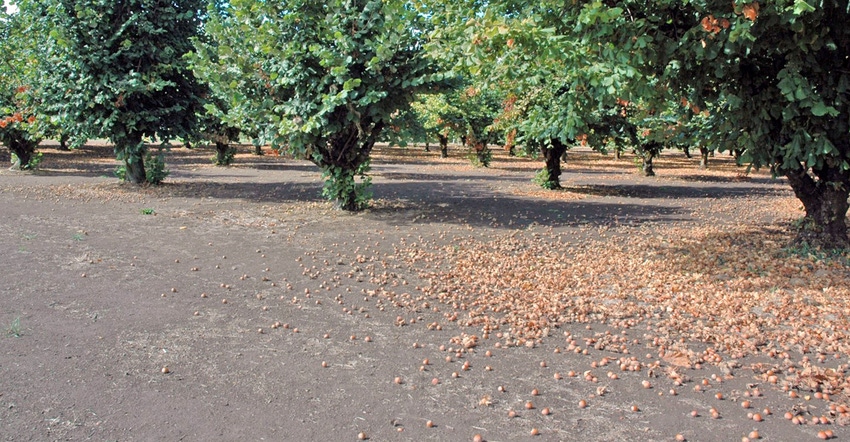October 15, 2018

Eastern filbert blight has taken its toll on Oregon orchards. From aggressive pruning to wholesale removal of trees for replacement with resistant varieties, growers have seen production rise and fall. But would fungicides help with mature trees as newer varieties mature? A new study from Oregon State University shows there’s value to fungicide use in preserving profit from mature trees.
“Although we have a lot of new hazelnut acres (almost 40,000) of EFB-resistant cultivars, the previous old, susceptible orchards (30,000 acres) are still producing as these young ones grow up,” says Jay Pscheidt, an OSU professor, OSU Extension Service plant pathology specialist and the lead author of the study. “It is worth noting that many old orchards are nearing the end of their productive life — as EFB is kind of like that old Space Invaders game, where it just keeps coming and coming, faster and faster.”
A look at the study
Fungicides have been known to be effective against EFB for some time; however, that early work was with non-bearing trees. OSU had the opportunity to work with a noninfected Ennis-variety orchard in the early 2000s. A one-acre orchard of Ennis hazelnut trees with Butler-variety pollenizers was planted in 1986 at a spacing of 19 feet by 19 feet and located at the Botany and Plant Pathology Field Laboratory, Corvallis, Ore. That orchard had been routinely sprayed with fungicide.
In 2004, a fungicide trial was established with a total of three treatments arranged in a randomized block design to test the value of the treatments. Each treatment consisted of four blocks containing nine trees each. The tested treatments included an untreated check, trees treated only with chlorothalonil (Bravo Weather Stik), and a best management practice (BMP) series using various fungicides in alternation with a variety of tankmixes.
The trial was conducted from 2004 through 2015, using orchard management as close to commercial norms as possible for weeds, insects, mites and suckers. Trees were lightly pruned during each dormant period to reduce tree height for better spraying by selectively removing the tallest branches.
EFB can develop over several years, and disease cankers were discovered in a nearby block of trees planted at the same time from identical stock. Cankers for EFB were first observed in the research block in 2010 on a single untreated tree and one tree in the BMP block. Those cankers were investigated and found to be 2 to 3 years old, meaning the orchard had been infected in 2007. The number of cankers from all untreated trees increased each year, but it declined in 2014. The number of cankers rose each year on all fungicide-treated trees, but nontreated trees always had more cankers than treated trees.
Returns rise
How did fungicide-treated plots fare over nontreated trees? A good measure is total gross returns from 2004 to 2015. For nontreated plots, total gross returns were $30,150 per acre; for chlorothalonil-treated plots, the return was $33,804 per acre; and for BMP trees, the return was $35,972 per acre. Total cost of fungicides for the same 12-year period was $1,230 per acre for chlorothalonil treatments and $1,848 per acre for BMP treatments. That means the fungicides protected a gross return of about $3,654 per acre for chlorothalonil treated areas and $4,724 per acre for BMP trees.
Fungicide use, the researchers concluded, not only limited EFB development but protected future yield loss and gross financial returns. Although the research was in small blocks of mature trees, the researchers reported that the results were similar to commercial industry’s experience. Essentially, the researchers note, growers who carry the cost of fungicides for multiple years should recoup those costs several years after discovery of the disease in their orchards.
The research was regularly supported in part by the Oregon Hazelnut Commission, which is a commodity commission and agency of the state of Oregon under the Oregon Department of Agriculture.
Source: Oregon State University
You May Also Like




